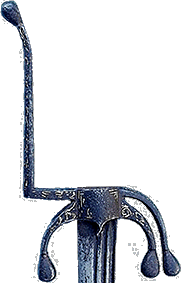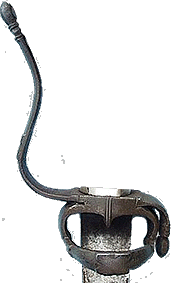Swords of the Museum: Nimcha 616 quarta-feira, 31 de janeiro de 2018 – Posted in: Arqueologia – Tags: Diego Conde Eguileta, Espadas Museu Ourense, Santiago Vilar Labarta
This article belongs in a series titled «Modern swords of the Ourense Archaeological Museum» which consists on technical files of the said Museum´s weapon collection. These files were documented by Juan Diego Conde Eguileta and Santiago Vilar Labarta who studied, besides their historical context and archaeological value, the fencing characteristics [or properties] of the swords. Due to their variety and singularity of some of the documented pieces, we think these files could be of interest for the HEMA community. You can read other articles in this series here.
The Archaeological Museum of Ourense keeps a large amount of pieces acquired by the Comisión Provincial de Monumentos Históricos y Artísticos de Ourense. This commision was founded August 8, 1844, and its function was to collect and guard the artistic heritage of the province. There is no data on the work of this commission until march 1898, when the bi-monthly publication of a newsletter begins, documenting its activities. The publication of these newsletters continued until 1960.
Among the many pieces purchased by the Comisión de Monumentos throughout the province of Ourense there are ten swords from the modern age. Of these pieces, the oldest can be dated in the end of the 17th century, and the most modern one in the beginnings of the 20th century. We had the privilege of being granted access to these swords in order to study them from both a historical and practical point of view. To perform this study we created a data collection template which allowed us to make a measurement of the pieces as exhaustive as possible. He curators of the museum even allowed us to wield them to adquire a better understanding of their use and functionality.
In this article we will talk about one of the latest pieces added into the collection, a nimcha, with catalogue number 616. But, before beginning the analysis of the item, it is necessary to explain what kind of weapon are we talking about.
The nimcha is a single edge sword used by the muslim peoples of the area between the west african coast and the Arabian Peninsula (both inclusive). This weapons are easy to identify due to the morphological characteristics of their hilt. Not so for their blades, because in for many of these swords those are of european origin (usually saber blades).
The identifying characteristics of a nimcha are as follows:
- Handle: can be made with various materials (ivory, tortoiseshell, wood, horn…). It´s shape can be curved or in lion´s head, with or without ears, as can be seen in the next picture.
- Tang: goes through the hilt and is fixed to it by a button-shaped rivet, or is riveted to a metal sheet of a size similar to the base of the hilt.
- Knuckle bow: starts from the cross-guard and its shape can be in right angle (original shape) or in “S” (later evolution).
- Crossguard: can be forward-swept, as the secondary upper quillion, or keep just this one, forward-swept too, while the quillions are joined together by forming a ring which protects the hand.
- Guarda de nimcha árabe
- Guarda de nimcha norteafricana
Once we have defined what a nimcha is, let´s perform the analisys of the one in the funds of the Archaeological Museum of Ourense. For that purpose we used a data collection sheet, where we detailed both the characteristics of the sword and the different parts of which is made. The information collected may seem too extensive, but those are data of interest for historical fencer, as they contribute with a lot of information about the behavior and characteristics of the sword, as far as handling is concerned.
SWORD
- Type: Nimcha
- Code: 616
- Total length: 73cm
- Weight: 600gr
- Point of Balance: 12.5cm
- Armorer marks: no visible marks.
- Kind of hilt: crossguard, knuckle bow and secondary upper quillion (now broken).
- Description: Nimcha from the north of Africa, single-edged blade but in the last 14 cm, in which it is double edged.
BLADE
- Number of planes: as a single edge blade, It´s formed by just two planes.
- Grooves: shallow groove near the back of the blade, which begins in the first third of the blade and extends along it, with the exception of the last 14 cm.
- Length: 58.4cm
- Width in the basis of the blade: 3.6cm
- Width in the middle of the blade: 3.3 cm
- Width in the point: 2cm
- Thickness at the basis of the blade: 0.4/0.2cm
- Thickness at middle blade: 0.4/0.2cm
- Thickness at the point: 0.2/0.2cm
The thickness comprises two numbers divided by a bar, which refer to the measures taken in the back/flat of the blade. - Tang: covered by the guard and the grip.
- Union with the pommel: has no pommel. However, there is a metal with three rivets at the end of the grip. This seems to maintain the blade attached to the grip.
- Description: single-edged blade but in the last 14 cm, in which it is double edged. The blade is almost straight, with a slight curve towards the back.
HILT
- Type: north african nimcha.
- Material: iron
- Armorer marks: no
- Radius: —
- Length of quillons: 4.8 cm
- Diameter of quillons: —
- Details of the quillons: rectangular section, with the end topped off in a button.
- Description: fore forward facing quillon, rectangular section knuckle bow attached to the end of the grip, and two upper quillions facing forward too (the second of them is actually broken).
HANDLE
- Length: 12.5 cm
- Width at the crossguard: 2.8cm
- Width at the middle: 3.1cm
- Width at the pommel: 2.5cm
- Material: horn.
- Description: made of carved horn, it has a ring of golden brass in the junction with the guard.
POMMEL
- The handle has a thickening behind the grip shaped like a “lion´s head” without “ears”. Lacks pommel.
We will now comment the collected data to facilitate its interpretation and allow our readers to get an idea as close as possible (with the limitations imposed by the written word) to the actual features of the piece.
As can be seen in the data sheet, it is a very light, relatively short sword, but with the point of balance forwards into the blade. The combination of these features gives a very nimble and manageable weapon, while retaining blade pressence (I can´t translate properly “presencia de hoja” to english). Saving distances, It´s usage would be very similar to that shown in medieval or renaissance treatises on langes messer.
Both blade morfology (flat and with a very narrow section) and the advanced point of balance give it good cutting ability. It´s a weapon more suitable to fight opponents without armour, which is to be expected in a 19th century sword.
The hilt, with its combination of iron quillons and knuckle bow, gives good protection to the hand. The shape of the handle facilitates gripping it, allowing the insertion of the pinky in the hollow formed between the grip and the “lion´s head” on the bottom. It also favours handling the sword as a saber, that is, placing the thumb in line with the back of the blade.Both morphological features of the quillons and the grip, as well as the material it´s made of, indicate that this is a nimcha from the North of África. Besides that, the blade is almost straight, slightly curving to the back which, along with its length and tha lack of armorer´s brand or other distinctive marks, make us think that it´s of local manufacture.
We can´t offer an exact dating of the piece as there is no documentary record of it´s entry in the museum. However, due to it´s geographical origin and that It´s entrance in the museum´s collection is previous to 1898 (start date of publication of the newsletter of the Commision of Monuments), we can suppose this is a sword manufactured in the 19th century. For this reason Is not too far fetched to suppose that it was used in the North African colonial wars of the second and third quarter of the 19th century. It could be a war spoil or have been purchased as a souvenir.
References
To identify the origin of a nimcha based on the morphology of its hilt, as well as to obtain the pictures of crossguard and handle used in this article, we visited the next web page: http://nimcha.fr/N-introd.htm .















